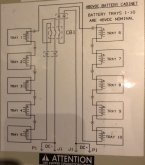salve
New Member
- Joined
- Jan 2, 2020
- Messages
- 43
Hi. I have a really basic question. I have my battery connected to the inverter. But I have to disconnect it to install the fuse box. Is there a safe way to disconnect it? Like the positive wire first or something? Last time I took it off (the positive, to install a bolt on fuse for the charge controller) when I put it back on there was a spark. I did what will said when I initially connected the battery to the inverter (using the resistor) so I know about that. How do I disconnect it and reconnect it so there's no spark/harm to the components?






